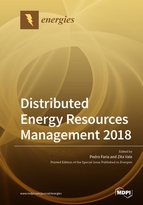Distributed Energy Resources Management 2018
A special issue of Energies (ISSN 1996-1073). This special issue belongs to the section "F: Electrical Engineering".
Deadline for manuscript submissions: closed (28 February 2019) | Viewed by 77472
Special Issue Editors
Interests: demand response; electricity markets; renewable energy integration; real-time simulation; smart grids; virtual power players
Special Issues, Collections and Topics in MDPI journals
Interests: artificial intelligence; demand response; electric vehicles; electricity markets; power and energy systems; renewable and sustainable energy; smart grids
Special Issues, Collections and Topics in MDPI journals
Special Issue Information
Dear Colleagues,
This Special Issue, “Distributed Energy Resources Management 2018”, is a continuation of the Special Issue “Distributed Energy Resources Management”. The success of the previous Special Issue shows the unquestionable relevance of distributed energy resources in the operation of power and energy systems at the distribution level, but also at the whole power system management level. Increased flexibility is required to accommodate intermittent distributed generation and electric vehicles charging. Demand response has a great potential to contribute to increased system efficiency while bringing additional benefits, namely to consumers. Distributed storage is also promising, especially when jointly used with photovoltaic panels. This Special Issue addresses the management of distributed energy resources with focus on methods and techniques to achieve an optimized operation, to aggregate the resources namely in the scope of virtual power players and other types of aggregators, and to remunerate them. The integration of distributed resources in electricity markets is also addressed as an enabler for their increased and efficient use.
Dr. Pedro Faria
Dr. Zita Vale
Guest Editors
Manuscript Submission Information
Manuscripts should be submitted online at www.mdpi.com by registering and logging in to this website. Once you are registered, click here to go to the submission form. Manuscripts can be submitted until the deadline. All submissions that pass pre-check are peer-reviewed. Accepted papers will be published continuously in the journal (as soon as accepted) and will be listed together on the special issue website. Research articles, review articles as well as short communications are invited. For planned papers, a title and short abstract (about 100 words) can be sent to the Editorial Office for announcement on this website.
Submitted manuscripts should not have been published previously, nor be under consideration for publication elsewhere (except conference proceedings papers). All manuscripts are thoroughly refereed through a single-blind peer-review process. A guide for authors and other relevant information for submission of manuscripts is available on the Instructions for Authors page. Energies is an international peer-reviewed open access semimonthly journal published by MDPI.
Please visit the Instructions for Authors page before submitting a manuscript. The Article Processing Charge (APC) for publication in this open access journal is 2600 CHF (Swiss Francs). Submitted papers should be well formatted and use good English. Authors may use MDPI's English editing service prior to publication or during author revisions.
Keywords
- demand response
- electricity markets
- renewable energy integration
- real-time simulation
- smart grids
- virtual power players
Benefits of Publishing in a Special Issue
- Ease of navigation: Grouping papers by topic helps scholars navigate broad scope journals more efficiently.
- Greater discoverability: Special Issues support the reach and impact of scientific research. Articles in Special Issues are more discoverable and cited more frequently.
- Expansion of research network: Special Issues facilitate connections among authors, fostering scientific collaborations.
- External promotion: Articles in Special Issues are often promoted through the journal's social media, increasing their visibility.
- Reprint: MDPI Books provides the opportunity to republish successful Special Issues in book format, both online and in print.
Further information on MDPI's Special Issue policies can be found here.







